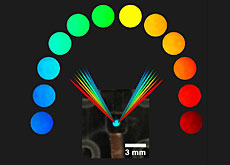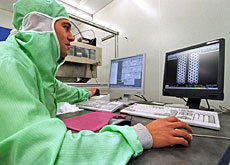A big future for the nano world

Nanotechnology is expected to open up new fields of scientific research and have a huge impact on society, although still in an early phase of development.
For Swiss businesses keen to tap into its “unlimited innovation potential”, the importance of partnerships with universities carrying out research into nanoscience is seen as crucial.
A conference on Monday hosted by the Federal Institute of Technology in Zurich threw light on the latest developments in “one of the key technologies of the 21st century”.
Nanoscience and nanotechnology involve studying and working with matter on an almost unimaginably small scale. One nanometre is one-millionth of a millimetre and a single human hair is around 80,000 nanometres in width.
Nanotechnologies are seen as having huge potential and benefits for society in areas as diverse as healthcare, information technology and energy storage.
Although a small country, Switzerland has an excellent international reputation in the nano world.
“[Switzerland’s] main assets are its capacity for innovation and its ability to adapt and exploit new technologies, integrating them into systems based on current mainstream technologies,” Christofer Hierold, head of the new Micro and Nano Science Platform, told swissinfo.
The institute currently has 40 research groups carrying out more than 270 interdisciplinary research projects at the “cutting edge” of nanoscience and is aiming to become one of the world’s top ten universities by 2020. It is forging closer links with industry as part of its strategic vision.
“We offer a unique research and development platform that is difficult to create within large industry,” Ernst Hafen, the institute’s president, told the audience.
Partners
The institute sees its partnerships with business as a win-win solution.
“Industry gets access to state-of-the art research and early innovative product ideas, while the university gains important leverage on projects, valuable funding, important contacts and relevant feedback from industry,” Hierold said.
But for a collaboration to be a success each side needs to accept that motivations might not always be the same, noted Claus Weyrich, head of corporate technology at German giant Siemens.
Still in its infancy, research is leading to the development of new materials that behave differently at the nanoscale. Nanomaterials can be stronger, lighter, and can conduct heat or electricity in a different way – they can even change colour.
Based on these and other special attributes, companies are developing products with special features, better performances, higher levels of integration and which are cheaper and more reliable.

More
Swiss Federal Institutes of Technology
New approach
Among the 60-plus projects on show was research into micro-robotics to help reduce damage to tissue, such as in the eye, or for building devices or blocks at the nanoscale.
The development of such increasingly complex materials and systems also brings with it the need for a different approach and the combination of knowledge across spheres of expertise.
“We need more interdisciplinary research into nanoscience to create even better new products,” Weyrich said.
While building ties with industry, the institute also wants to take an active role in educating and informing another key partner – the general public – about the benefits and risks of nanoparticles.
“I know from my experience as a biologist in the genetically modified food debate, where people had entrenched opinions, that it is important to initiate dialogue with the public early on,” Hafen said.
swissinfo, Simon Bradley
Nanoscience and nanotechnology encompass a range of techniques rather than a single discipline and stretch across the scientific spectrum, touching on medicine, physics, engineering and chemistry.
The size and scale of the nanotechnology industry is unclear in Switzerland. One reason is the lack of an international standard definition of the science, making it hard to determine whether companies use nanotechnology or not.
A 2004 report by the Royal Society in Britain estimated research and development on nanotechnology to be worth some SFr1.57 billion ($1.2 billion) a year in Europe.
This compares with $800 million (SFr650 million) in Japan in 2003, $3.7 billion for a US project lasting from 2005 to 2008 (excluding defence expenditure) and a pledge from the British government to spend $78.5 million a year on nanotechnology between 2003 and 2009.
The federal environment and health offices are currently working, in parallel with the EU, on a nanoscience risk and regulations action plan to be published at the end of 2006.
The Micro and Nano Science Platform is a network of researchers within the Federal Institute of Technology in Zurich with the aim of promoting research and education, technology development and transfer in the field of micro- and nanosciences. Members include professors and scientists from 40 research groups from nine departments and centres.

In compliance with the JTI standards
More: SWI swissinfo.ch certified by the Journalism Trust Initiative



You can find an overview of ongoing debates with our journalists here . Please join us!
If you want to start a conversation about a topic raised in this article or want to report factual errors, email us at english@swissinfo.ch.